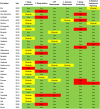Prognostic factors for falls in Parkinson's disease: a systematic review
- PMID: 38015306
- PMCID: PMC10965733
- DOI: 10.1007/s13760-023-02428-2
Prognostic factors for falls in Parkinson's disease: a systematic review
Abstract
Background: Falls represent a critical concern in Parkinson's disease (PD), contributing to increased morbidity and reduced quality of life.
Purpose: We conducted a systematic review to assess the prognostic factors associated with falls in PD, aiming to provide a comprehensive overview of relevant demographic and clinical parameters, and aid neurologists in identifying subsets of PD patients most susceptible to falls and associated injuries.
Methods: PubMed and Web of Science databases were searched for prospective studies assessing factors associated with falls in ambulatory PD patients across different settings, from inception to August 2023. Data extraction was conducted using CHARMS-PF checklist and risk of bias was assessed with QUIPS tool. PRISMA guidelines were followed.
Results: The initial search yielded 155 references. Thirty-four studies, involving a total of 3454 PD patients, were included in the final analysis. The mean pooled age was 67.6 years, and 45.1% were women. PD patients presented mild motor impairment (UPDRS III score 27.8) with mean pooled disease duration of 5.7 years. Gait and balance disorders and history of prior falls emerged as the most consistent predictors of falls across studies. Disease duration, disease severity, dysautonomic symptoms, freezing of gait, frontal cognitive functions, and PD medication dosages yielded inconsistent findings. Conversely, dyskinesias, age, sex, and depression were unrelated to future falls in PD. Logistic regression models were most commonly employed to identify factors significantly associated with falls in PD. Substantial heterogeneity prevailed in the inclusion of confounding factors.
Conclusion: The evidence suggests that previous history of falls, gait disorders, and poor balance are robust prognostic markers for falls in PD.
Keywords: Balance; Falls; Freezing of gait; Gait; Parkinson’s disease; Prognostic factors.
© 2023. The Author(s).
Conflict of interest statement
The authors have not received any funding from any institution, including personal relationships, interests, grants, employment, affiliations, patents, inventions, honoraria, consultancies, royalties, stock options/ownership, or expert testimony for the last 12 months.
Figures
Similar articles
-
Physical exercise for people with Parkinson's disease: a systematic review and network meta-analysis.Cochrane Database Syst Rev. 2023 Jan 5;1(1):CD013856. doi: 10.1002/14651858.CD013856.pub2. Cochrane Database Syst Rev. 2023. Update in: Cochrane Database Syst Rev. 2024 Apr 08;4:CD013856. doi: 10.1002/14651858.CD013856.pub3. PMID: 36602886 Free PMC article. Updated.
-
Freezing of gait and fall detection in Parkinson's disease using wearable sensors: a systematic review.J Neurol. 2017 Aug;264(8):1642-1654. doi: 10.1007/s00415-017-8424-0. Epub 2017 Mar 1. J Neurol. 2017. PMID: 28251357 Free PMC article.
-
Cholinesterase inhibitors for dementia with Lewy bodies, Parkinson's disease dementia and cognitive impairment in Parkinson's disease.Cochrane Database Syst Rev. 2012 Mar 14;2012(3):CD006504. doi: 10.1002/14651858.CD006504.pub2. Cochrane Database Syst Rev. 2012. PMID: 22419314 Free PMC article.
-
Subthalamic and nigral stimulation for freezing of gait in Parkinson's disease: Randomized pilot trial.J Parkinsons Dis. 2024 Nov;14(8):1602-1613. doi: 10.1177/1877718X241292315. Epub 2025 Jan 17. J Parkinsons Dis. 2024. PMID: 39957196 Clinical Trial.
-
Interventions for preventing falls in Parkinson's disease.Cochrane Database Syst Rev. 2022 Jun 6;6(6):CD011574. doi: 10.1002/14651858.CD011574.pub2. Cochrane Database Syst Rev. 2022. PMID: 35665915 Free PMC article.
Cited by
-
Relationship of foot pain with the increased risk of falls in patients with Parkinson's disease.J Foot Ankle Res. 2024 Dec;17(4):e70023. doi: 10.1002/jfa2.70023. J Foot Ankle Res. 2024. PMID: 39666372 Free PMC article.
-
Machine Learning Predicts Risk of Falls in Parkison's Disease Patients in a Multicenter Observational Study.Eur J Neurol. 2025 May;32(5):e70118. doi: 10.1111/ene.70118. Eur J Neurol. 2025. PMID: 40304115 Free PMC article.
-
Cognitive markers of resilience to dementia in mild Neurocognitive Impairment: a meta- analysis.Neurol Sci. 2025 Jun;46(6):2401-2418. doi: 10.1007/s10072-025-08080-3. Epub 2025 Mar 3. Neurol Sci. 2025. PMID: 40032754
-
Risk factors for falls in Parkinson's disease: a cross-sectional observational and Mendelian randomization study.Front Aging Neurosci. 2024 Jun 10;16:1420885. doi: 10.3389/fnagi.2024.1420885. eCollection 2024. Front Aging Neurosci. 2024. PMID: 38915347 Free PMC article.
-
Cueing-assisted gamified augmented-reality gait-and-balance rehabilitation at home for people with Parkinson's disease: protocol of a pragmatic randomized controlled trial implemented in the clinical pathway.Front Neurol. 2025 Feb 24;16:1512409. doi: 10.3389/fneur.2025.1512409. eCollection 2025. Front Neurol. 2025. PMID: 40066314 Free PMC article.
References
Publication types
MeSH terms
LinkOut - more resources
Full Text Sources
Medical




